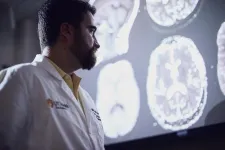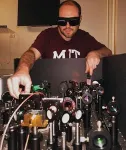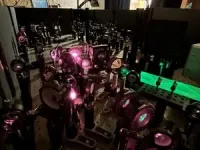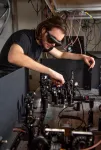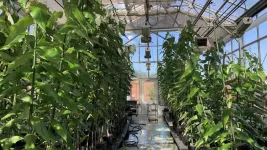(Press-News.org) SAN ANTONIO (July 13, 2023) — An artificial intelligence (AI) tool developed at The University of Texas Health Science Center at San Antonio accurately counts brain lesions on MRI scans within seconds. Once it is adapted to the clinic, the AI tool should help neuroradiologists to evaluate patients’ brain diseases at earlier stages.
“Certain kinds of brain lesions are tremendously difficult to quantify without AI,” said researcher Mohamad Habes, PhD, of the health science center’s Glenn Biggs Institute for Alzheimer’s and Neurodegenerative Diseases. Habes is assistant professor of radiology and director of the Biggs Institute neuroimaging core.
In a study published April 24 in JAMA Network Open, Habes and colleagues from eight institutions demonstrated the AI tool’s utility in identifying and counting enlarged perivascular spaces (ePVS’s). These spaces, filled with cerebrospinal fluid, surround arteries and veins and are a marker of cerebral small-vessel disease that can lead to stroke and dementia. The study was a follow-up analysis of 1,026 individuals who participated in the Multi-Ethnic Study of Atherosclerosis (MESA).
“We have developed an innovative deep-learning tool to precisely quantify every single enlarged perivascular space in the brain and provide us with a map of the patient’s small-vessel disease,” Habes said.
Taking a painstaking task and making it possible
Before this tool, ePVS’s were ignored because of the difficulty of counting them on MRI scans.
“On average a middle-aged person might have maybe 500 or 600 of these small spaces on an MRI,” Habes said. “Think about a neuroradiologist who is going to sit down and count all of them. That’s not really going to happen. He or she would spend one or two hours per scan, or even more, and that amount of laborious effort is not feasible in the workflow of a busy clinic.”
The team described the automated deep-learning method for ePVS detection in the journal Neuroimage: Reports on March 7. “We have trained an algorithm with expert knowledge to be able to quantify these lesions on its own,” Habes said. “This tool recognizes them, tells us their exact locations, counts them and tells us their volumes. It tells us a ton of information about them, far more than what a human can do.”
In the JAMA Network Open report, Habes and coauthors studied enlarged perivascular spaces throughout the brain.
“Before, people were not able to do whole-brain ePVS quantification,” Habes said. “We can now do it with our advanced deep learning tools. In our study, we realized that enlarged perivascular spaces in two regions, the basal ganglia and the thalamus, are the most significant lesions because they showed association with stroke and small-vessel disease markers.”
The basal ganglia is a deep-brain region important for neurodegenerative disorders and is related to movement and decision-making, Habes said. The thalamus, a region near the basal ganglia, is related to sensory functions such as taste and touch.
The researchers’ hope is that the AI tool for enumerating brain lesions will be further studied at the Alzheimer’s Disease Research Centers (ADRCs), which are U.S. National Institute on Aging-Designated Centers of Excellence. The South Texas ADRC, the only such center in Texas, is a collaboration of UT Health Science Center San Antonio’s Biggs Institute with The University of Texas Rio Grande Valley.
“This is a great breakthrough for our ADRC, which is focusing a lot on cerebrovascular disease and its contribution to dementia,” Habes said. “This is one of the unique themes of our ADRC, and we think our novel AI methodology can benefit large-scale studies conducted across the nation’s ADRCs.”
The AI tool leverages the power of UT Health Science Center San Antonio’s Genie supercomputer, Habes said.
Assessment of Risk Factors and Clinical Importance of Enlarged Perivascular Spaces by Whole-Brain Investigation in the Multi-Ethnic Study of Atherosclerosis
Sokratis Charisis, MD; Tanweer Rashid, PhD; Hangfan Liu, PhD; Jeffrey B. Ware, MD; Paul N. Jensen, PhD; Thomas R. Austin, PhD; Karl Li, MD, PhD; Elyas Fadaee, MD; Saima Hilal, MD, PhD; Christopher Chen, MD; Timothy M. Hughes, PhD; Jose Rafael Romero, MD; Jon B. Toledo, MD, PhD; Will T. Longstreth Jr, MD; Timothy J. Hohman, PhD; Ilya Nasrallah, MD, PhD; R. Nick Bryan, MD, PhD; Lenore J. Launer, PhD; Christos Davatzikos, PhD; Sudha Seshadri, MD; Susan R. Heckbert, MD, PhD; Mohamad Habes, PhD
First published: JAMA Network Open, April 24, 2023
https://jamanetwork.com/journals/jamanetworkopen/fullarticle/2803993
The University of Texas Health Science Center at San Antonio (UT Health San Antonio), a primary driver for San Antonio’s $44.1 billion health care and biosciences sector, is the largest academic research institution in South Texas with an annual research portfolio of more than $360 million. Driving substantial economic impact with its six professional schools, a diverse workforce of 7,900, an annual operating budget of $1.23 billion and clinical practices that provide 2.6 million patient visits each year, UT Health San Antonio plans to add more than 1,500 higher-wage jobs over the next five years to serve San Antonio, Bexar County and South Texas. To learn about the many ways “We make lives better®,” visit UTHealthSA.org.
The Glenn Biggs Institute for Alzheimer’s and Neurodegenerative Diseases is dedicated to providing comprehensive dementia care while advancing treatment through clinical trials and research. The Biggs Institute is a National Institute on Aging (NIA)-designated Alzheimer’s Disease Research Center (ADRC). In addition to patient care and research, the Biggs Institute partners with the School of Nursing at UT Health San Antonio to offer the Caring for the Caregiver program.
Stay connected with The University of Texas Health Science Center at San Antonio on Facebook, Twitter, LinkedIn, Instagram and YouTube.
END
UT Health Science Center San Antonio develops tool that counts brain lesions in seconds
Novel AI algorithm precisely quantifies perivascular spaces that signal risk of stroke
2023-07-13
ELSE PRESS RELEASES FROM THIS DATE:
New ways of getting to the heart of the matter
2023-07-13
Peter Keyel, an associate professor in Texas Tech University’s Department of Biological Sciences, has received an Innovative Project Award from the American Heart Association to study atherosclerosis, the condition that causes arteries to thicken and can trigger a variety of devastating health complications.
Statistics indicate diseases linked to atherosclerosis are the leading cause of death in the U.S. with as many as half of Americans between the ages of 45 and 84 having the condition but being unaware of its slow progression and ...
Researchers establish criterion for nonlocal quantum behavior in networks
2023-07-13
A new theoretical study provides a framework for understanding nonlocality, a feature that quantum networks must possess to perform operations inaccessible to standard communications technology. By clarifying the concept, researchers determined the conditions necessary to create systems with strong, quantum correlations.
The study, published in Physical Review Letters, adapts techniques from quantum computing theory to create a new classification scheme for quantum nonlocality. This not only allowed the researchers to unify ...
Youth of color turn to TikTok for diet, fitness information
2023-07-13
FOR IMMEDIATE RELEASE
Thursday, July 13, 2023
Contact:
Jillian McKoy, jpmckoy@bu.edu
Michael Saunders, msaunder@bu.edu
##
Youth of Color Turn to TikTok for Diet, Fitness Information
A new study found that social media platforms, particularly TikTok and Instagram, are ideal spaces to educate and guide US youth of color on healthy weight management and ultimately reduce racial inequities in obesity.
Nearly 1 in 4 adolescents in the United States experienced obesity from 2017 to ...
Controlling quantum randomness from the vacuum
2023-07-13
A team of researchers from the Massachusetts Institute of Technology has achieved a milestone in quantum technologies, demonstrating for the first time the control of quantum randomness.
The team of researchers focused on a unique feature of quantum physics known as "vacuum fluctuations". You might think of a vacuum as a completely empty space without matter or light. However, ...
Building a better forest tree with CRISPR gene editing
2023-07-13
Researchers at North Carolina State University used a CRISPR gene-editing system to breed poplar trees with reduced levels of lignin, the major barrier to sustainable production of wood fibers, while improving their wood properties. The findings – published in the journal Science – hold promise to make fiber production for everything from paper to diapers greener, cheaper and more efficient.
Led by NC State CRISPR pioneer Rodolphe Barrangou and tree geneticist Jack Wang, a team of researchers used predictive modeling to set goals of lowering lignin levels, increasing the carbohydrate to lignin (C/L) ratio, and increasing the ratio of two important ...
Special Issue: A machine-intelligent world
2023-07-13
In this special issue of Science, nine pieces – including Perspectives, Policy Forums, and Reviews – highlight recent advancements in artificial intelligence (AI) technologies and how they’re being used to answer novel questions in topics ranging from human health to animal behavior. However, the recent widespread adoption of AI in these areas is not without unique ethical concerns and policy challenges. “By looking to the forefront of how AI is being used in science and society, many grand challenges and benefits appear,” writes Gemma Alderton, deputy editor at Science.
AI-predicted ...
Genetic editing of wood for sustainability
2023-07-13
Despite the importance of wood fibers to meet the growing demand for renewable tissue, paper, packaging, textile, and other fiber products, wood fiber production has been less efficient and productive than researchers have hoped. Now, CRISPR editing has enabled scientists to design wood in which lignin – which must be cleaved and dissolved so fiber production can take place – is more suitable for fiber production. “The edited wood alleviates a major fiber-production bottleneck … and could bring unprecedented operational efficiencies, bioeconomic ...
Use of ChatGPT improves productivity, with particular benefits to those with weaker skills
2023-07-13
The use of ChatGPT – a chatbot that can generate human-like text – raises productivity in professional writing tasks and reduces productivity inequality in those who use it, according to a new study involving over 400 college-educated professionals. Although the findings reveal direct and immediate effects of ChatGPT on worker productivity, study authors Shakked Noy and Whitney Zhang note that longer-term impacts on complex labor market dynamics, which will likely arise as firms and workers adapt to ChatGPT, remain unknown. “Overall, the arrival of ChatGPT ushers ...
Chagas Disease is also underdiagnosed in Spain
2023-07-13
A high percentage of people from Latin America are infected with the parasite that causes Chagas disease. This is the conclusion of an analysis of nearly 3,000 people from countries where the disease is endemic and who attended the International Health Service at Barcelona’s Hospital Clinic, over a 17-year period. The study, published in PLOS Neglected Tropical Diseases, was led by the Barcelona Institute for Global Health (ISGlobal), an institution supported by "la Caixa" Foundation.
Nearly 7 million people in the world are estimated to be infected ...
Improving high-temperature stability of perovskite solar cells
2023-07-13
Perovskite solar cells (PSCs) have gained attention for their high power-conversion efficiencies and low-cost solution processing. However, ensuring their stability at high temperatures has been a challenge, as the points of contact between their different layers (“interfaces”) are susceptible to degradation, leading to energy loss and decreased performance.
In a new study, researchers have found that they can minimize PSC degradation at high temperatures by using fluorinated aniliniums, a class of compounds used in pharmaceuticals, agrochemicals, and materials science. The study was led ...
LAST 30 PRESS RELEASES:
Understanding the role of linear ubiquitination in T-tubule biogenesis
Researchers identify urban atmosphere as primary reservoir of microplastics
World’s oldest arrow poison – 60,000-year-old traces reveal early advanced hunting techniques
Bristol scientists discover early sponges were soft
New study uncovers how rice viruses manipulate plant defenses to protect insect vectors
NSF–DOE Vera C. Rubin Observatory spots record-breaking asteroid in pre-survey observations
Ribosomal engineering creates “super-probiotic” bacteria
This self-powered eye tracker harnesses energy from blinking and is as comfortable as everyday glasses
Adverse prenatal exposures linked to higher rates of mental health issues, brain changes in adolescents
Restoring mitochondria shows promise for treating chronic nerve pain
Nature study identifies a molecular switch that controls transitions between single-celled and multicellular forms
USU chemists' CRISPR discovery could lead to single diagnostic test for COVID, flu, RSV
Early hominins from Morocco reveal an African lineage near the root of Homo sapiens
Small chimps, big risks: What chimps show us about our own behavior
We finally know how the most common types of planets are created
Thirty-year risk of cardiovascular disease among healthy women according to clinical thresholds of lipoprotein(a)
Yoga for opioid withdrawal and autonomic regulation
Gene therapy ‘switch’ may offer non-addictive pain relief
Study shows your genes determine how fast your DNA mutates with age
Common brain parasite can infect your immune cells. Here's why that's probably OK
International experts connect infections and aging through cellular senescence
An AI–DFT integrated framework accelerates materials discovery and design
Twist to reshape, shift to transform: Bilayer structure enables multifunctional imaging
CUNY Graduate Center and its academic partners awarded more than $1M by Google.org to advance statewide AI education through the Empire AI consortium
Mount Sinai Health system receives $8.5 million NIH grant renewal to advance research on long-term outcomes in children with congenital heart disease
Researchers develop treatment for advanced prostate cancer that could eliminate severe side effects
Keck Medicine of USC names Christian Pass chief financial officer
Inflatable fabric robotic arm picks apples
MD Anderson and SOPHiA GENETICS announce strategic collaboration to accelerate AI-driven precision oncology
Oil residues can travel over 5,000 miles on ocean debris, study finds
[Press-News.org] UT Health Science Center San Antonio develops tool that counts brain lesions in secondsNovel AI algorithm precisely quantifies perivascular spaces that signal risk of stroke
